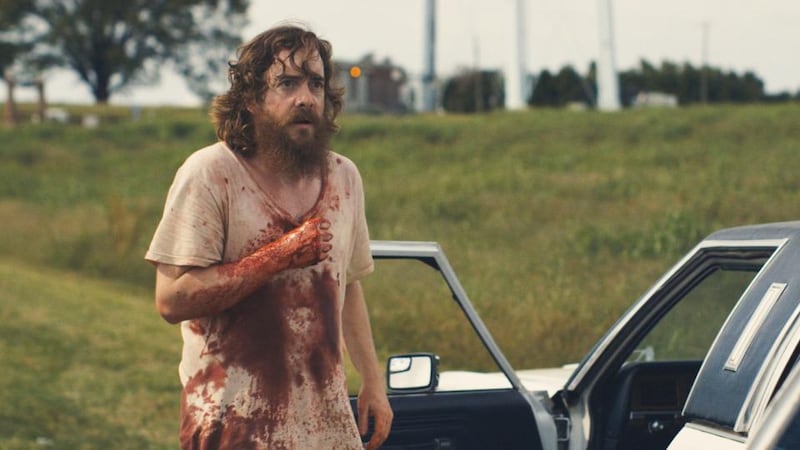Precedent is everything in movie marketing. So don't be surprised, in coming weeks, if you happen upon phrases such as "the hottest American indie since Reservoir Dogs" and "This year's Blood Simple" attached to the nail-biting new revenge thriller Blue Ruin. At 37, Jeremy Saulnier, the film's writer, director and cinematographer, is an overnight sensation. And it's only taken some 26 years.
The story behind Blue Ruin begins during the 1980s in suburban Alexandria, Virginia, where a group of rambunctious, pre-teen filmmakers started recreating their favourite scenes from Reagan-era actioners.
“My dad was a car guy and he was in the air force,” recalls Saulnier. “So growing up I did a lot of fine-scale modelling with him. I’d take action figures and paint up their vehicles and burn them. I’d do snowscapes with white sheets and pillows. One weekend my mom, who was a researcher, brought home a portable video machine. That changed my life. And it didn’t take long to find likeminded people. A group of us came together as a collective when most of us were 11 years old, and started working as a crew.”

Thus, long before he attended film school at NYU, Saulnier and chums were working with blood squibs and “fairly sophisticated special effects”. Post-graduation, Saulnier drifted into the commercials sector and most of his Alexandria cohorts found other things to do.
“You have to weigh up what’s good for your pocket and what’s good for your soul,” shrugs Saulnier. “Commercials can be lucrative. You are compensated for a skill set. But it’s all about a certain veneer. It’s all about being trendy. As far as creativity goes, it didn’t really work for me.”
With all his bills paid, in 2007, Saulnier's self-financed debut feature, Murder Party – a vomit-heavy horror comedy – won the audience award at Slamdance. He was soon offered work in the same mondo genre. But the film was not the springboard to greater things that the film-maker had hoped for.
“You can learn a craft,” says the director. “You can have an aptitude for visual storytelling. But it’s an industry, and making connections within that industry can still be a brick wall. It’s hard to make sure your scripts are read. It’s hard to persuade people to trust you with their money.”
In recent years he has worked as a cinematographer on critically acclaimed US indies such as Putty Hill. But it required a $45,000 Kickstarter campaign and a professional reunion with Macon Blair – star of Saulnier's earliest shorts – to get Blue Ruin off the ground.
"The first film Macon and I made together was Megacop," laughs Saulnier. "I was 11, he was 12. It was bits of Miami Vice and Commando. Wigs. Toy guns. Exploding paint packets on our chests. All in-camera editing. So we were very disciplined. I'm spoiled because of Macon. I know have outrageous physical expectations from all actors. Because I'm so used to attaching firecrackers to him."
As it turns out, Macon Blair is a revelation as Dwight, the lost soul at the heart of Blue Ruin. A shuffling, broken man who lives in his car, Dwight is stirred into action by news that the man who killed his parents is getting released from prison. He soon catches up with the killer, only to reignite an ancient family feud.
At first glance, it's a perfectly formed vengeance thriller replete with inventive viscera and heart-pounding stand-offs; look again and it's a clever deconstruction of that same genre. Think somewhere in the region of Chan-Wook Park's Vengeance Trilogy or Jean-Pierre Melville's Le Samouraï.
“When I first pictured the character years ago he was darkly comic in the way that a lot of 1990s stuff was,” says Saulnier. “But in the current climate of abhorrent gun violence in America, it felt off to say: ‘I’m going to make an awesome gun flick.’ I wanted to make something with emotional weight and to veer away from the traditional American vengeance thriller. It was important to use elements of that for the bedrock of the story. So you do have all that traditional masculine aggression. But we subvert those expectations.”
Saulnier had a wonderful film in the can but Blue Ruin almost didn't make it into a multiplex near you. Having scrambled to make the deadline for last year's Sundance Film Festival, the initial rough cut – featuring 'scene missing' boards – was rejected by programmers.
“That definitely burst my bubble a bit,” says Saulnier. “So we retreated back to our day jobs. And I starting coping with the idea that this wasn’t going to be the breakthrough I had hoped for. That was almost liberating in the end. Because I wasn’t worried anymore about getting the hot premiere. It became about making the film as good as it can be because it was probably the last film I’d ever make.”
He was driving to a corporate video shoot in Cleveland, Ohio, when the call came from the Cannes Film Festival. Forget Sundance – Blue Ruin had been selected for Director's Fortnight. It went on to win the FIPRESCI Prize.
“We used Cannes as a kind of deadline. But that was just for us. That was shooting the moon. I had already accepted that the film was not getting into a top tier festival. I’m still not sure I didn’t dream the entire thing. It’s not what I’m used to. But I’m not taking a minute of this for granted.”
Blue Ruin is in cinemas now












